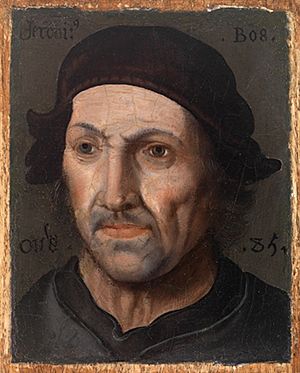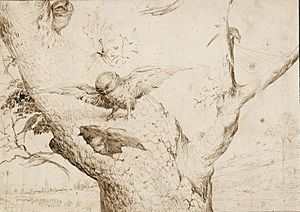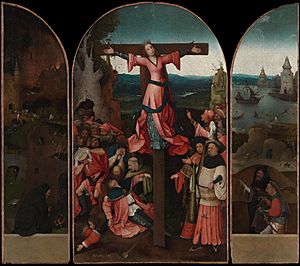Hieronymus Bosch facts for kids
Quick facts for kids
Hieronymus Bosch
|
|
|---|---|
| Jheronimus Bosch | |

Posthumous portrait of Hieronymus Bosch, c. 1585
(attr. Anonymous) |
|
| Born |
Jheronimus van Aken
c. 1450 |
| Died | Buried on 9 August 1516 (aged 65–66) 's-Hertogenbosch, Duchy of Brabant, Habsburg Netherlands
|
| Known for | Painting |
|
Notable work
|
The Garden of Earthly Delights The Temptation of St. Anthony |
| Movement | Early Netherlandish, Renaissance |
Hieronymus Bosch (born Jheronimus van Aken around 1450 – August 9, 1516) was a famous Dutch painter. He came from a region called Brabant. Bosch is known as one of the most important artists of the Early Netherlandish painting style.
His paintings were usually made with oil on oak wood. They often show amazing and sometimes strange pictures of religious stories and ideas. During his lifetime, people in the Netherlands, Austria, and Spain collected his art. Many artists also copied his work, especially his spooky and dream-like pictures of hell.
Contents
Life of Hieronymus Bosch
We don't know much about Bosch's life. He was born Jheronimus van Aken. His last name, "van Aken," means "from Aachen." However, his artist name, Bosch, comes from his hometown, 's-Hertogenbosch. This name means "Duke's forest," but people often called it "Den Bosch," which means "the forest."
Early Life and Family
We are not exactly sure when Bosch was born. Experts guess it was around 1450. This guess is based on a drawing of him made just before he died in 1516. The drawing shows him as an older man, probably in his late sixties.
Bosch lived his whole life in or near 's-Hertogenbosch. This city was in the Duchy of Brabant. His grandfather, Jan van Aken, was also a painter. He is first mentioned in records from 1430. Jan had five sons, and four of them became painters too. Bosch's father, Anthonius van Aken, was an art advisor. He worked for a group called the Illustrious Brotherhood of Our Blessed Lady.
Most people believe that Bosch learned to paint from his father or one of his uncles. Sadly, none of their paintings still exist today. Bosch's name first appears in city records on April 5, 1474. He is mentioned along with his two brothers and a sister.
Life in 's-Hertogenbosch
's-Hertogenbosch was a busy and rich city in the 1400s. It was in the southern part of what is now the Netherlands. At that time, it was part of the Burgundian Netherlands. Later, it became part of the lands ruled by the Habsburg family.
In 1463, a terrible fire destroyed four thousand houses in the town. Bosch was about thirteen years old then, so he probably saw this huge fire. He became a very popular painter during his lifetime. People from other countries often asked him to paint for them.
Around 1486 or 1487, Bosch joined the Brotherhood of Our Lady. This was a respected group of about forty important citizens from 's-Hertogenbosch. They were a religious group who helped each other.
Marriage and Death
Between 1479 and 1481, Bosch married Aleyt Goyaerts van den Meerveen. She was a few years older than him. The couple moved to a nearby town called Oirschot. Aleyt had inherited a house and land from her wealthy family there.
Records from the Brotherhood of Our Lady mention Bosch's death in 1516. A special church service was held in his memory on August 9 of that year.
Hieronymus Bosch's Artworks
Bosch did not write dates on his paintings. However, he did sign some of them, which was unusual for artists at that time. Today, about twenty-five paintings are believed to be truly his.
In the late 1500s, Philip II of Spain bought many of Bosch's paintings. Because of this, the Prado Museum in Madrid, Spain, now has some of his most famous works. These include The Adoration of the Magi, The Garden of Earthly Delights, and The Haywain Triptych.
Types of Paintings
Bosch created at least sixteen triptychs. A triptych is a painting made of three panels that are hinged together. Eight of his triptychs are still complete today, and parts of five others remain.
Art experts usually divide Bosch's works into three periods:
- Early works: Around 1470–1485.
- Middle period: Around 1485–1500.
- Late period: From about 1500 until his death.
Bosch's Unique Style
Bosch sometimes painted in a quick, rough way. His paintings have textured surfaces, which is called impasto. This was different from other famous Dutch painters of his time. They usually made very smooth paintings.
His art often showed a dark and imaginative style. This style greatly influenced other artists in Northern Europe during the 1500s. Today, Hieronymus Bosch is seen as a truly unique painter. He had a deep understanding of what people desire and what they fear most.
His most well-known works are his large triptychs, like The Garden of Earthly Delights.
See also
 In Spanish: El Bosco para niños
In Spanish: El Bosco para niños
- List of paintings by Hieronymus Bosch
- List of drawings by Hieronymus Bosch
Images for kids







